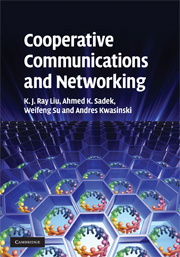Book contents
- Frontmatter
- Contents
- Preface
- Part I Background and MIMO systems
- Part II Cooperative communications
- 4 Relay channels and protocols
- 5 Cooperative communications with single relay
- 6 Multi-node cooperative communications
- 7 Distributed space–time and space–frequency coding
- 8 Relay selection: when to cooperate and with whom
- 9 Differential modulation for cooperative communications
- 10 Energy efficiency in cooperative sensor networks
- Part III Cooperative networking
- References
- Index
4 - Relay channels and protocols
from Part II - Cooperative communications
Published online by Cambridge University Press: 06 July 2010
- Frontmatter
- Contents
- Preface
- Part I Background and MIMO systems
- Part II Cooperative communications
- 4 Relay channels and protocols
- 5 Cooperative communications with single relay
- 6 Multi-node cooperative communications
- 7 Distributed space–time and space–frequency coding
- 8 Relay selection: when to cooperate and with whom
- 9 Differential modulation for cooperative communications
- 10 Energy efficiency in cooperative sensor networks
- Part III Cooperative networking
- References
- Index
Summary
In this chapter, we will discuss shortcomings of conventional point-to-point communications that led to the introduction of the new paradigm shift for wireless communications, i.e., cooperative communications. We will define what the relay channel is, and in what aspects it is different from the direct point-to-point channel. We will also describe several protocols that can be implemented at the relay channel, and discuss the performance of these protocols which will be assessed based on their outage probability and diversity gains.
Cooperative communications
In cooperative communications, independent paths between the user and the base station are generated via the introduction of a relay channel as illustrated in Figure 4.1. The relay channel can be thought of as an auxiliary channel to the direct channel between the source and destination. A key aspect of the cooperative communication process is the processing of the signal received from the source node done by the relay. These different processing schemes result in different cooperative communications protocol. Cooperative communications protocols can be generally categorized into fixed relaying schemes and adaptive relaying schemes. In fixed relaying, the channel resources are divided between the source and the relay in a fixed (deterministic) manner. The processing at the relay differs according to the employed protocol. In a fixed amplify-and-forward (AF) relaying protocol, the relay simply scales the received version and transmits an amplified version of it to the destination.
- Type
- Chapter
- Information
- Cooperative Communications and Networking , pp. 119 - 151Publisher: Cambridge University PressPrint publication year: 2008
- 1
- Cited by



